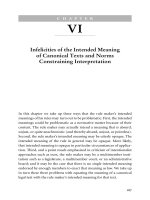Stop And Go Yes And No
Bạn đang xem bản rút gọn của tài liệu. Xem và tải ngay bản đầy đủ của tài liệu tại đây (12.98 MB, 34 trang )
by Brian P. Cleary
illustrated by Brian Gable
THIS PAGE
INTENTIONALLY
LEFT BLANK
es
n, who appreciat
my brother Kevi nguage
To
ur la
the richness of o
—B.P.C.
Antonym:
A word that
means the
opposite of
d
another wor
by Brian P. Cleary
illustrated by Brian Gable
J M ILLBROOK P RESS / M INNEAPOLIS
Antonyms are opposites—
they’re words like
stop and g
o.
S
Th ey’re just like
e?
fferent those word
di
sa
how
r
ee
yes and no.
Big and small
are antony ms,
and so
ar e
f r ont
and back
,
fast
and
slow
and
high
and
low,
as well as wh ite and
black.
Up and down
are antonyms
just like
excite and sooth e,
left and righ t
and dark and light,
and also
r o ugh
and
smooth .
If it weren’t for opposites,
we’d have no way to say,
“I’d like to h ave
my chocolate hot,
’cause it’s so
cold today!”
And wh at if we could only
ev er say th at we w
er e
sad
?
Because of antonyms,
when things are righ t,
we’l l say we
ad .
’r e gl
Like safe
compared to
like
dangerous,
heavy is to light,
y to bold
sh
and
young to old
and even
dim to brigh t,
th ey’re opposite
in meaning
as in
quie tly
and loudly.
Th ey show a total contrast
just like
shamefully
and
proudly.
Sometimes antonyms
are made
with “un” before a word.
This is how we get
unkind,
u nable,
an d
rd .
u nh e a
Often adding “dis”
or “im”
or sometimes even “non”
will help you build an
antonym
with th ese beginnings on.
For example,
r espect,
s
di
impossible,
nonfiction.
Their prefixes are helpful
in displaying contradiction.
yms help us divi
ton
de
An
sur r
ne.
ounded fr om alo
And help compare
the
to the totally
famous
unknown.









